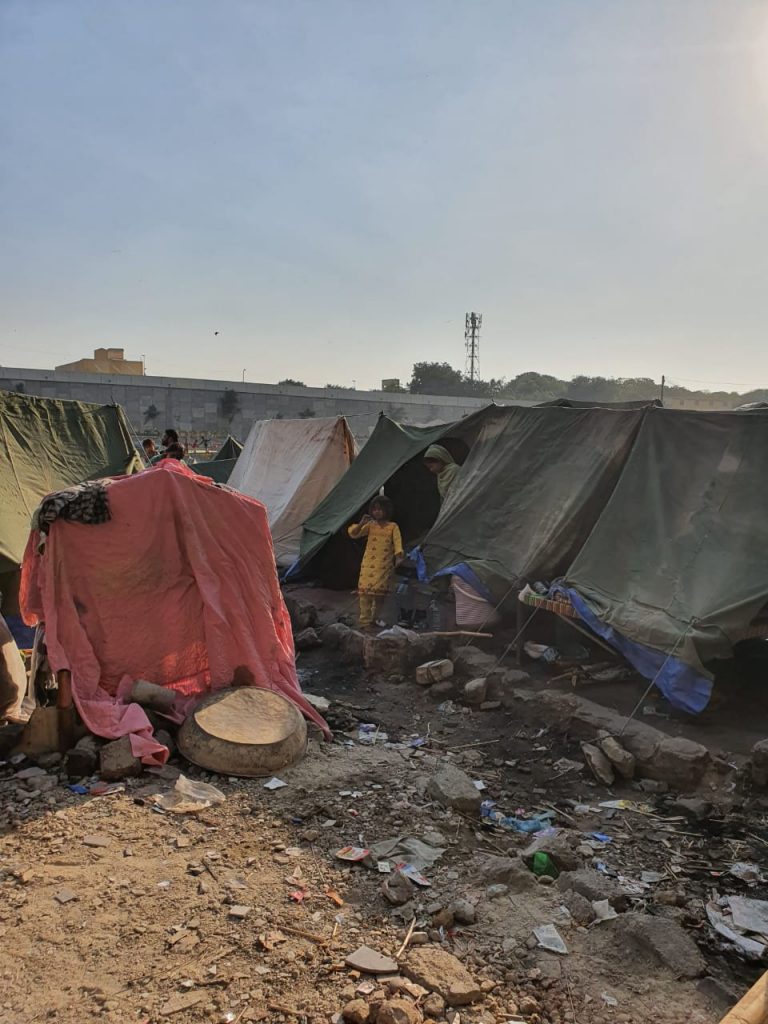
#1: Fire tenders with the help of water tankers provided by the Karachi Water and Sewerage Board put out the fire by 2am.
Fire brigade officials told news organisations that they were called to the scene at approximately 10pm and the fire was extinguished around 2:30am. The Soch Fact Check team visited Teen Hatti to establish a timeline of events. Multiple affectees confirmed on the record that the fire started between 9pm and 10pm. Nearly all residents were adamant that the fire had largely died down by the time the fire officers arrived – at 11pm. Our survey of the area made it clear that when the fire was put out, it had already burned through most of the slum.
Most residents claimed that assistance arrived in phases, not all at once as stated by the Station Fire Officer. Three eyewitnesses reported that initially only one fire truck arrived, followed by the rest 20-30 minutes later. Other residents claimed that between the time they arrived at the scene and the fire brigade began putting out the fire, around 60% of the slum had already burned to the ground. We asked the fire department for a statement but have yet to receive a response.
VERDICT: Kind of true, kind of false
#2: Hundreds of dwellings were destroyed and no casualties were reported.
Both the residents and government officials could not ascertain the exact number of settlements affected. The informal settlement was densely packed, an estimated 150-350 dwellings were said to have burnt down. Although the exact number remains unclear, it is important to mention all sides confirmed that every tent home in the area was reduced to ashes. No casualties were reported.

VERDICT: True
#3: All affectees will be given permanent homes in Prime Minister Imran Khan’s Naya Pakistan Shelter Home.
Pakistan Tehreek-e-Insaf MNA Dr Amir Liaquat Hussain from the NA-245 constituency, visited the area and promised the affectees they would be rehabilitated into new homes in the PM’s housing scheme. No official word has come from the PM House.
It is yet to be seen whether this promise will be upheld. We will update the story accordingly.
#4: Humanitarian aid is being distributed amongst residents in large amounts.
It was reported in the media that various charitable organizations, as well as representatives from the chief minister’s office and political parties, distributed humanitarian aid to the affectees. Soch surveyed the residents of the affected slum to gauge whether the proclaimed efforts reached those in need.. We discovered that although food and water was being supplied by various charitable organisations such as Edhi Foundation, Al Wasila, and others, many residents complained that other necessary items such as blankets, clothes, and tents were not available in sufficient quantity, which led to disputes breaking out among the affectees.
Several residents complained of mismanagement. They lamented that the resources, which were few to begin with, were being poorly distributed. Women and persons with disabilities were especially at a disadvantage when it came to receiving these goods. Moreover, affectees who are camped in makeshift shelters, away from the main road, were also deprived of the aid that arrived. Women and the disabled are at a disadvantage when it came to receiving these goods.. Some affectees alleged that resources were being being handed to non-affectees due to a lack of verification of their identity by aid distributors. Soch learnt that some distributed items were being pawned in nearby markets by non-residents.
VERDICT: Kinda True, Kinda False
#5: Aid slips distributed to all affectees based on a list of affectees prepared by community leaders to facilitate the distribution of humanitarian goods.
Soch acquired the list of affectees that was referred to in media reports, compiled by community leaders. Numerous community leaders and residents confirmed that aid was being distributed upon verification of residency through CNICs. Unfortunately, some people with the appropriate documentation were still not included on the list. It is important to clarify that the current list is incomplete. As of Wednesday, January 23, 244 affected persons were recorded on the list, however, most reports estimate at least 400 residents were affected by the fire. If there were 150 settlements destroyed, the lower-bound estimate in the news, it is very likely that the list is far from complete.
CNICs are being used to provide identification slips, which affected residents can use to collect aid, however, many of the residents have lost or damaged their CNICs in the fire.
Ultimately, fair distribution of resources can only take place by bringing community members on board and expending the required amount of effort in making sure resources do not fall into the wrong hands.
VERDICT: Kinda true, kinda false
This is a developing story that is being updated as the situation evolves.
